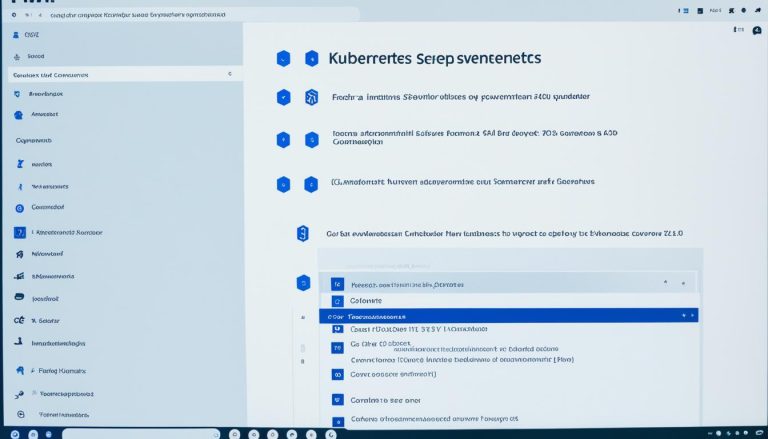Understanding ext4 fs: A Deep Dive Guide
In this comprehensive guide, I will take you on a deep dive into the ext4 file system. As Linux’s native file system, ext4 (or the Fourth Extended Filesystem) offers numerous features and advantages over its predecessor, ext3. Whether you’re a sysadmin, a developer, or simply a Linux enthusiast, understanding ext4 will empower you to maximize the performance and storage capabilities of your Linux platforms.
Before we delve into the details, let’s address some key points about ext4. First released as an extension to the ext3 file system, ext4 has now become the default choice for many popular Linux distributions. It is designed to overcome the limitations of ext3 and offers enhanced performance, reliability, and scalability.
In this guide, we will explore the compatibility of ext4, its history, notable features, advantages, and disadvantages. Additionally, we will compare ext4 with other Linux file systems to help you make informed decisions. So, let’s begin our journey into the world of ext4 and uncover everything you need to know about this powerful file system.
Key Takeaways:
- ext4 is Linux’s native file system and offers numerous features and advantages over ext3.
- It is the default file system for many popular Linux distributions.
- ext4 is not compatible with Windows and macOS, but there are workarounds to mount ext4 on these operating systems.
- The ext file system has a rich history, evolving from Minix to ext2 and then to ext3.
- ext4 provides features like larger file system sizes, extents, delayed allocation, online defragmentation, and backward compatibility with ext2 and ext3.
Ext4 File System Compatibility
The Ext4 file system, widely used in Linux distributions like Ubuntu and Debian, offers robust performance and data management capabilities. However, it is important to note that Ext4 is officially incompatible with Windows and macOS operating systems. This can present challenges for users who need to access Ext4 files on these platforms.
Fortunately, there are workarounds available to mount Ext4 on Windows, enabling users to read and write to Ext4 partitions. One approach is to use third-party applications, such as Ext2Fsd or DiskInternals Linux Reader, which provide Ext4 file system compatibility on Windows. Another option is to leverage the Windows Subsystem for Linux (WSL 2), which allows users to run a Linux environment within Windows and access Ext4 files seamlessly.
For macOS users, accessing Ext4 files is also possible through various methods. One solution is to use software like macFUSE, which enables mounting of Ext4 partitions and provides read and write capabilities. Additionally, virtual machine hosts like VirtualBox or VMware can be utilized to create a Linux virtual machine on macOS, allowing access to Ext4 files.
Mounting Ext4 on Windows
- Third-party applications like Ext2Fsd or DiskInternals Linux Reader are popular options to mount Ext4 on Windows.
- The Windows Subsystem for Linux (WSL 2) provides a Linux environment within Windows, enabling seamless access to Ext4 files.
Accessing Ext4 Files on macOS
- macFUSE is a tool that allows mounting of Ext4 partitions on macOS, providing read and write access to Ext4 files.
- Virtual machine hosts like VirtualBox or VMware can be used to create a Linux virtual machine on macOS, allowing access to Ext4 files.
By utilizing these methods, users can overcome the compatibility limitations and effectively work with Ext4 file systems on Windows and macOS platforms.
History of Ext File System
The Ext file system has a rich history. It was initially created in 1987 as an extension to overcome the limitations of the Minix file system. However, it quickly evolved into Ext2, a more successful version that was widely used in Linux distributions for many years. Ext3 was then introduced with the goal of improving recovery time after system crashes by introducing journaling features.
The Ext file system was developed as an extension to address the limitations of the Minix file system, which was the default file system in the early days of Linux. Minix had a limited maximum file size and file system size, which hindered its usability for larger-scale applications. To overcome these limitations and provide better support for larger file systems, developers created the Ext file system.
With the release of Ext2, the Ext file system gained significant popularity in the Linux community. Ext2 brought several improvements compared to its predecessor, including support for larger file sizes, larger file systems, and a more efficient data structure that reduced disk fragmentation. These advancements made Ext2 a reliable choice for many Linux users, and it remained the default file system for numerous distributions for a long time.
However, despite its success, Ext2 had one major drawback: recovery time after system crashes. Without journaling capabilities, Ext2 required a lengthy file system check (fsck) process after a crash, which could lead to extended downtime. To address this issue, developers introduced Ext3, which added journaling features to ensure faster recovery and reduced system downtime.
The addition of journaling to Ext3 significantly improved its reliability and recovery time after crashes. By recording file system changes in a journal before applying them to the main file system, Ext3 could recover more quickly and efficiently in the event of a system failure. This made Ext3 a preferred choice for Linux users who prioritized system stability and uptime.
Overall, the Ext file system, starting from Ext2 and continuing with Ext3, played a vital role in the advancement of Linux file systems. While Ext3 remains a reliable option for many users, it eventually gave way to Ext4, the fourth version of the Ext file system, which introduced additional features and enhancements for improved performance and data integrity.
Continue reading to discover the features and advantages of Ext4 in the next section.
Features of Ext4
Ext4 offers several advanced features that contribute to its exceptional performance, reliability, and versatility. By leveraging these features, users can optimize their storage systems and enhance overall efficiency.
1. File System Size
One of the key advantages of Ext4 over its predecessor, Ext3, is its support for larger file system sizes. Ext4 allows for significantly increased storage capacity, enabling users to manage and store a vast amount of data efficiently.
2. Extents
Extents in Ext4 enable efficient file allocation and minimize fragmentation. Instead of using individual blocks, Ext4 groups contiguous blocks together in extents, reducing the number of disk accesses required to read or write data and improving overall I/O performance.
3. Delayed Allocation and Multiblock Allocation
Ext4 employs delayed allocation and multiblock allocation strategies to optimize memory usage and disk operations. Delayed allocation delays the actual allocation of blocks until necessary, reducing unnecessary disk writes. Multiblock allocation allocates multiple blocks at once, enhancing throughput and reducing metadata overhead.
4. Online Defragmentation
With online defragmentation, Ext4 dynamically organizes the file system in the background without interrupting ongoing operations. This process consolidates fragmented files, improves file access time, and ensures optimal disk space utilization.
5. Journal Checksumming
Ext4 provides enhanced data integrity through journal checksumming. This feature checks the integrity of the file system’s journal, reducing the risk of data corruption and maintaining the overall stability and consistency of the system.
6. Inodes/Timestamps
Ext4 supports larger inodes, which store important metadata about files and directories. This allows for efficient file management and retrieval. Additionally, Ext4 provides more accurate timestamps, including creation, modification, and access times, facilitating precise tracking and monitoring of file activities.
7. Backward Compatibility
Ext4 ensures backward compatibility with its predecessors, Ext2 and Ext3. This compatibility allows for a seamless transition to Ext4 without the need for extensive data migration, providing users with a smooth upgrade path while preserving data integrity and compatibility with existing applications and systems.
| Feature | Description |
|---|---|
| File System Size | Support for larger file system sizes |
| Extents | Efficient file allocation and reduced fragmentation |
| Delayed Allocation and Multiblock Allocation | Optimized memory usage and disk operations |
| Online Defragmentation | Dynamic organization of the file system in the background |
| Journal Checksumming | Enhanced data integrity and reduced corruption risk |
| Inodes/Timestamps | Larger inodes and more accurate timestamps for precise file management |
| Backward Compatibility | Seamless compatibility with Ext2 and Ext3 |
Advantages and Disadvantages of Ext4
Ext4, the Fourth Extended Filesystem, offers several advantages that make it a popular choice for Linux users. However, it also comes with some disadvantages worth considering.
Advantages of Ext4
- High performance: Ext4 is optimized for speed and efficiency, allowing for faster file system access and improved overall system performance.
- Reliable journaling: Ext4 incorporates journaling, a feature that helps ensure the integrity of the file system, protecting against data loss in the event of a system crash or power failure.
- Support for large files and partitions: Ext4 supports significantly larger files and partitions compared to its predecessor, Ext3, making it suitable for handling large-scale data storage and processing tasks.
- Backward compatibility: Ext4 is backward compatible with Ext2 and Ext3, allowing users to easily upgrade their file systems without the need for extensive data migrations or conversions.
- Encryption capabilities: Ext4 provides the ability to encrypt specific volumes, enhancing the security of sensitive data stored on the file system.
To summarize:
| Advantages of Ext4 |
|---|
| High performance |
| Reliable journaling |
| Support for large files and partitions |
| Backward compatibility with Ext2 and Ext3 |
| Encryption capabilities |
Disadvantages of Ext4
- Increased administration overhead: Ext4 requires more administration and maintenance compared to simpler file systems, as it offers advanced features that need proper configuration and management.
- Potential for wasted disk space: Ext4’s allocation policies may lead to wasted disk space, especially when dealing with many small files or fragmented data.
- Challenges in creating consistent snapshots: Ensuring consistent and reliable snapshots across different volumes can be challenging with Ext4, requiring additional tools or techniques.
To summarize:
| Disadvantages of Ext4 |
|---|
| Increased administration overhead |
| Potential for wasted disk space |
| Challenges in creating consistent snapshots |
While Ext4 offers numerous advantages, such as high performance, reliable journaling, and support for large files and partitions, it is important to be aware of its potential downsides, including increased administration overhead, possibility of wasted disk space, and challenges in creating consistent snapshots.
By considering these advantages and disadvantages, you can make an informed decision on whether Ext4 is the right file system for your specific needs and use cases.
Working With Ext4
Creating and managing files on the Ext4 file system is a fundamental aspect of utilizing its capabilities. This section explores the necessary steps to create files on Ext4, mount the file system, and set parameters to customize its behavior.
Creating Files on Ext4
To create files on Ext4, you need to format the partition with the Ext4 file system using the
1 | <a class="wpil_keyword_link" href="https://www.howto-do.it/mkfs-ext4/" title="mkfs.ext4" data-wpil-keyword-link="linked">mkfs.ext4</a> |
command. This command initializes the file system, allocating space for the files and directories to be created. By specifying the target partition or device and the file system type, the command swiftly sets up the Ext4 file system.
Note: The
command should be executed with caution, as it formats the partition and erases any existing data. Make sure to back up important data before proceeding.
Mounting the Ext4 File System
After creating the Ext4 file system, the next step is to mount it to a specific mount point. Mounting establishes the connection between the file system and the directory hierarchy, allowing the files and directories within the Ext4 file system to be accessed and managed.
The
1 | mount |
command is used to mount the Ext4 file system, specifying the device or partition containing the Ext4 file system and the target mount point. Once mounted, the Ext4 file system becomes accessible, enabling file operations such as reading, writing, and deleting.
Setting Parameters for Mounting
When mounting the Ext4 file system, you have the option to set parameters that customize its behavior to better suit your needs. These parameters can enhance performance, improve reliability, or provide additional features.
Some common parameters that can be set during the mounting process include:
- Journaling Mode: Specifies the level of journaling for metadata updates, allowing you to balance performance and data integrity.
- Reserved Blocks: Reserves a certain percentage of disk space for privileged processes, preventing file system fragmentation and ensuring system stability.
- Mount Options: Defines additional behaviors such as read-only mounting, access permissions, and error handling.
By carefully selecting and configuring these parameters, you can optimize the performance and reliability of the Ext4 file system to meet your specific requirements.
Summary
In this section, we explored the process of working with the Ext4 file system. We learned how to create files on Ext4 by formatting the partition using the
1 | mkfs.ext4 |
command. We also discussed the steps involved in mounting the Ext4 file system to a specific mount point and explored the customization options available by setting parameters during the mount process. Understanding these essential tasks and configurations is crucial for effectively utilizing the Ext4 file system and maximizing its potential.
Ext4 vs Other Linux File Systems
When it comes to choosing the right file system for your Linux environment, Ext4 is just one of many options available. It is often pitted against other file systems like XFS, Btrfs, and ZFS, each with its own set of features, advantages, and considerations.
“The choice of file system ultimately depends on your specific needs and requirements. Understanding the differences between Ext4 and other Linux file systems can help you make an informed decision.”
Let’s take a closer look at how Ext4 compares to these alternatives:
| File System | Features | Advantages | Considerations |
|---|---|---|---|
| Ext4 | Efficient file allocation, journaling, large file system sizes | High performance, backward compatibility with Ext2/Ext3, encryption | Potential for wasted disk space, increased administration overhead |
| XFS | Handling of large files and file systems, scalability | Optimal performance, good support for parallel I/O | Limited file system repair options |
| Btrfs | Copy-on-write functionality, snapshots, checksumming | Data pooling, efficient space utilization, easy administration | Less mature compared to Ext4 and XFS, potential for performance issues |
| ZFS | Data integrity, built-in RAID, snapshots | Powerful storage management, advanced data protection | Higher memory requirements, licensing considerations |
As seen in the comparison table, each file system offers unique features and advantages. Ext4 stands out with its efficient file allocation and journaling capabilities, making it a reliable choice for many Linux distributions. XFS excels in handling large files and file systems, while Btrfs provides advanced features like snapshots and data pooling. ZFS offers powerful storage management and data integrity features.
Ultimately, the decision between Ext4 and other Linux file systems depends on your specific requirements and priorities. Consider factors such as performance, scalability, data integrity, administration overhead, and support for advanced features when making your choice.
Comparing Ext4 and Btrfs
In particular, a closer examination of Ext4 and Btrfs can shed light on their unique characteristics:
- Efficiency: Ext4 excels in efficient file allocation and has a mature codebase. On the other hand, Btrfs provides copy-on-write functionality, allowing for more efficient snapshots and checksumming.
- Scalability: Both Ext4 and Btrfs can handle large file systems, but Btrfs offers greater scalability with support for larger file sizes and partitions.
- Administration: Ext4 is well-established and widely supported, making administration relatively straightforward. Btrfs, while feature-rich, is still considered less mature than Ext4 and may require more careful consideration and monitoring.
In conclusion, when comparing Ext4 to other Linux file systems, it is essential to evaluate their features, advantages, and considerations. By understanding these differences, you can make an informed decision and choose the most suitable file system for your specific needs in the Linux ecosystem.
Linux Permissions and Security
In the Linux world, permissions and security are essential aspects of managing access to files and directories. Understanding and effectively implementing Linux permissions, file ownership, groups, and Access Control Lists (ACLs) play a crucial role in maintaining the security and efficiency of your Linux environment.
Linux permissions determine the level of access granted to users for reading, writing, and executing files and directories. Permissions are assigned to three categories: owners, groups, and others. The owner of a file or directory has the highest level of control, followed by the group, and then others. By carefully managing permissions, you can ensure that only authorized users can access, modify, or execute specific files or directories, while preventing unauthorized access and potential security breaches.
File ownership is an important concept in Linux. Each file and directory is associated with an owner, typically the user who created it. The owner has special privileges to control the access and modification rights of the file. By understanding file ownership and effectively assigning owners, you can manage file-level security and ensure that only authorized users can access and modify sensitive data.
Groups
In addition to individual file ownership, Linux also utilizes groups to manage file access and permissions. Groups allow you to assign multiple users to a common group with shared access rights. By creating and managing groups, you can simplify the administration of file permissions, granting or revoking access for multiple users simultaneously.
Access Control Lists (ACLs)
Access Control Lists (ACLs) are an advanced feature in Linux that provides granular control over file and directory permissions. ACLs allow you to define specific access rules for individual users and groups, granting or denying them permissions beyond the standard Linux permission system. With ACLs, you can grant read, write, and execute permissions to specific users or groups, further enhancing file-level security and maintaining fine-grained control over file access.
Implementing Linux permissions, file ownership, groups, and ACLs effectively is essential for maintaining a secure Linux environment. By understanding these key concepts and utilizing them appropriately, you can ensure that your files and directories are accessible only to authorized users, preventing unauthorized access, and protecting sensitive data. Take the time to review and understand the permissions and access control mechanisms available in Linux, and tailor them to your specific security requirements. With proper implementation, you can create a robust and secure Linux environment.
File Systems in Linux
In the Linux ecosystem, there are various file systems that offer unique features and advantages. Understanding these file systems can help you choose the most suitable one for your needs.
Ext4
Ext4 is the default file system for many Linux distributions. It is an upgraded version of the Ext3 file system and offers improved performance and reliability. Ext4 supports larger file system sizes and file sizes compared to Ext3, making it ideal for handling large amounts of data.
XFS
XFS, on the other hand, is known for its exceptional handling of large files and file systems. It excels in scalability and performance, making it suitable for enterprise-level applications that require extensive storage capabilities.
Btrfs
Btrfs, short for “B-Tree File System,” provides advanced features like snapshots and data pooling. It offers data integrity through checksumming and supports online defragmentation. Btrfs is designed to optimize the storage system and is particularly well-suited for scenarios where data redundancy and flexibility are paramount.
“Each file system has its own strengths and caters to different use cases. Ext4, XFS, and Btrfs are just a few examples of the file systems available in Linux, providing a wide range of options for users to choose from.”
| File System | Features | Advantages |
|---|---|---|
| Ext4 | Improved performance and reliability, larger file system sizes and file sizes | Default file system for many Linux distributions, backward compatibility with Ext2 and Ext3, encryption capabilities |
| XFS | Exceptional handling of large files and file systems | Scalability, high performance |
| Btrfs | Snapshots, data pooling, checksumming, online defragmentation | Data redundancy, storage optimization |
The choice of file system depends on the specific requirements of your system and workload. By understanding the features and advantages of each file system, you can make an informed decision to optimize your Linux storage infrastructure.
Ext4 File System Commands
Working with the Ext4 file system requires familiarity with various commands that enable you to perform essential operations. These commands allow you to format partitions, create files, mount the file system, and more, providing you with the tools to effectively manage your Ext4 file system.
Here are some essential Ext4 commands:
Formatting a Partition with Ext4
When you need to format a partition with the Ext4 file system, you can use the mkfs.ext4 command. This command initializes the partition with the Ext4 format, preparing it for use.
Creating Files
The touch command allows you to create new files on a mounted Ext4 file system. Simply specify the file name as an argument, and the command will create an empty file in the current directory.
Mounting the File System
To access the files on an Ext4 file system, you need to mount it to a specific directory in your Linux environment. The mount command, along with the correct options, enables you to mount an Ext4 file system and make its contents accessible.
Other Operations
In addition to the basic formatting, file creation, and mounting commands, there are various other operations you can perform on an Ext4 file system. These include managing file permissions with chmod, changing ownership with chown, and listing directory contents with ls.
By mastering these Ext4 commands, you can confidently navigate and manipulate your Ext4 file system, leveraging its capabilities to their fullest.

Remember, exercising caution when working with file systems is crucial, as the wrong command or operation can lead to data loss or system instability. Always double-check your commands and ensure you have proper backups before making any significant changes.
Conclusion
Understanding the intricacies of the Ext4 file system is crucial for maximizing storage capabilities and performance on Linux platforms. By exploring its compatibility, history, features, advantages, and disadvantages, as well as comparing it with other Linux file systems, you can make informed decisions when utilizing the Ext4 file system.
The Ext4 file system, also known as the Fourth Extended Filesystem, offers several advantages over its predecessor, Ext3. It provides high performance, reliable journaling, support for large files and partitions, and backward compatibility with Ext2 and Ext3. Additionally, Ext4 allows for the encryption of specific volumes, ensuring data security.
However, there are certain considerations to keep in mind. Increased administration overhead, potential wasted disk space, and challenges in creating consistent snapshots across different volumes are some of the disadvantages of Ext4. These factors need to be carefully evaluated in relation to specific use cases and requirements.
When choosing a file system for your Linux environment, it’s essential to weigh the pros and cons of Ext4 against other options such as XFS, Btrfs, and ZFS. Each file system has its own unique features and considerations, and understanding these differences will help you select the most suitable solution for your needs.
FAQ
What is the Ext4 file system?
The Ext4 file system, also known as the Fourth Extended Filesystem, is Linux’s native file system designed to address the limitations of the previous version, Ext3. It offers various features and advantages compared to Ext3.
Is Ext4 compatible with Windows and macOS?
No, Ext4 is officially incompatible with Windows and macOS. However, there are ways to mount Ext4 on Windows using third-party apps or the Windows Subsystem for Linux (WSL 2). Mac users can access Ext4 files using tools like macFUSE, virtual machine hosts, or third-party apps.
What is the history of the Ext file system?
The Ext file system was initially created in 1987 as an extension to overcome the limitations of the Minix file system. It evolved into Ext2, a more successful version widely used in Linux distributions. Ext3 was later introduced with journaling features, leading to the development of Ext4.
What are the features of Ext4?
Ext4 offers larger file system sizes and file sizes compared to Ext3. It supports extents for efficient file allocation, delayed allocation and multiblock allocation for optimized memory usage and disk operations, online defragmentation for improved performance, journal checksumming for data integrity, and larger inodes and more accurate timestamps.
What are the advantages and disadvantages of Ext4?
Ext4 has advantages such as high performance, reliable journaling, support for large files and partitions, backward compatibility with Ext2 and Ext3, and the ability to encrypt specific volumes. However, it has disadvantages including increased administration overhead, potential for wasted disk space, and challenges in creating consistent snapshots across different volumes.
How do I work with Ext4?
To create files on Ext4, you need to format the partition with the Ext4 file system using the mkfs.ext4 command. You can then mount the file system to a specific mount point. Additionally, you can set parameters for mounting the Ext4 file system to customize its behavior.
How does Ext4 compare to other Linux file systems?
Ext4 is often compared to file systems such as XFS, Btrfs, and ZFS. Each file system has its own unique features and considerations. Understanding the differences between them can help you choose the most suitable file system for your specific needs.
What are Linux permissions and security?
Linux permissions include read, write, and execute permissions assigned to owners, groups, and others. Ownership, groups, and Access Control Lists (ACLs) play a crucial role in managing access to files and directories, ensuring the security and efficiency of a Linux environment.
What are the different file systems in Linux?
Linux supports various file systems, including Ext4, which is the default file system for many Linux distributions. XFS is known for handling large files and file systems, while Btrfs provides advanced features like snapshots and data pooling.
What are the commands for working with the Ext4 file system?
There are various commands available to work with the Ext4 file system, including formatting a partition with Ext4, creating files, mounting the file system, and performing other operations. Familiarizing yourself with these commands will enable you to effectively manage your Ext4 file system.
Why is understanding the Ext4 file system important?
Understanding the intricacies of the Ext4 file system is essential for maximizing storage capabilities and performance on Linux platforms. By exploring its compatibility, history, features, advantages, and disadvantages, as well as comparing it with other Linux file systems, you can make informed decisions when utilizing the Ext4 file system.
- About the Author
- Latest Posts
Mark is a senior content editor at Text-Center.com and has more than 20 years of experience with linux and windows operating systems. He also writes for Biteno.com






